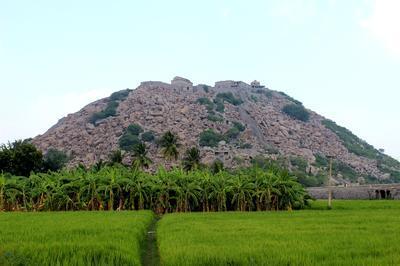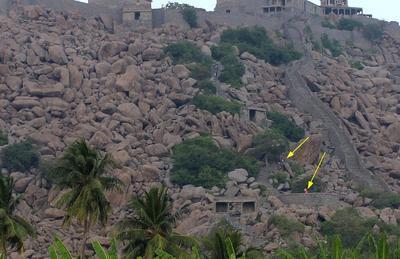
The above image of Gingee Fort Hill (GFH) should cause one to wonder what created it. A more unusual geologic feature might be difficult to find. It is a massive shroud of boulders covering a large geologic intrusion. It is man made. Several reasons point in that direction. The standard geologic narrative states water polishes stone, but that is a two hundred-year-old myth. Rocks with a pebble finish are the product of plasma connections. Therefore, terrain around the hill should have a few boulders like those on the hill scattered over the landscape, but none are seen. The terrain is remarkably and unnaturally free of such rocks.
When Z-Pinch Aurora (ZPA) form over terrain, its plasma connects, if strong enough, to earth's creating zp-prints like those seen around Gesico, Sardinia. When this occurs, a layer of bedrock is converted to plasma. A small portion of rock is broken down into colluvium, fig3. Since the source of gravity is plasma, ZPA exert their own gravitational attraction1. Colluvium is caught between the two gravitational fields of earth and ZPA. As the ZPA drift (east to west), its attraction declines and earth's attraction exerts itself. The first points of attraction are caves, wells and hillsides, otherwise, colluvium descends VERY SLOWLY to the earth's surface. Colluvium's distinguishing feature is a random mixture of course and fine material. It is the origin of soil. Large cobbles are found buried randomly in fine particles unlike a deposition by water where heavy objects are deposited first then fine particles. There is more to this story, but this will assist the reader in understanding GFH.

All rock covering GFH was a product of plasma connections. They range from very large to massive. The hill is too perfect to be a creation of Mother Nature. The vast majority of its rock was not the product of connections in the immediate vicinity. ZPA created them but could not channel boulders to one location. The landscape is pristine in regard to huge boulders because man gathered and put them on the hill. Utilization of this otherwise useless material was remarkably creative, and rendered it assault proof. This is the first indication that man created GFH.

The second indicator is the bushes. As stated above, colluvium is a mixture of course and fine material, fig3. If GFH was a natural deposition, then a lot of soil would accompany the accumulation of boulders. If soil was present among the rocks then a lot of bushes would be growing over the hillside. As can be seen that is not the case. Wind blown dust is flushed to the bottom. The hill is nothing but a very large pile of very large boulders. Someone swept the countryside clear of boulders and deposited them on GFH. Only the Antecedents had the technical skills for that job. It could not be done without plasma technology to levitate, move and deposit rocks on GFH.
What distinguishes Antecedent construction is its monumental scale. Antecedent Egyptians built pyramids and moved the 850 ton Colossi of Memnon. They also dredged Lake Birket and systematically piled up very large hills of material. Antecedent Levantines used three massive Trilithon blocks in the foundation of the equally massive Temple of Jupiter. At Lake Copias, Greece, nearly two billion tons of rock and soil were moved for water management purposes. GFH is another example of a monumental technical feat by Antecedents. This technology was known worldwide, but the Great Technology Reset, i.e. Pleistocene Catastrophe, sent survivors back to the Stone Age. Ignorance surrounding Antecedent achievements is sustained by superstitions peddled by academics, e.g. hunter-gatherers. A day will come when tomorrow will be catastrophically different from yesterday. The z-pinches are coming back.
ZPA exert a force like gravity's inverse square law.↩︎

